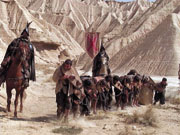
(Photo Courtesy IDFA 2002)
 |
Those who have been delighted in the past by the madly gleeful, incredibly
dark, and incisively sharp worlds created by Terry Gilliam would be overjoyed
to venture into a cinema and take a look at "The Man Who Killed Don Quixote".
Unfortunately, these admirers must face the disappointment that this film will
not soon be forthcoming in any cinema near anyone. After five short
production days (following ten long years of preparation) sufficient disaster
had struck the project to bring the end quickly in sight and make it
inevitable. Giants, it seems, come in all shapes and sizes. Scheduling
rehearsals with major stars was near impossible, costume fittings were
difficult to arrange, extras arrived on location for shooting without having
been rehearsed beforehand, promised studios turned out to be steel corrugated
warehouses with incredible sound problems, a nearby air base had F-16s flying
over locations every few minutes and, last but not least (in any terms), the
noted French actor Jean Rochefort developed a health problem that appeared to
be situated in his prostate, but later turned out to be a double hernia on
his vertebrae. The second time the lead actor managed to climb upon his
horse, it took two men to help him off it again and forty painridden minutes
to walk back to his car and leave. This, after preparing for nearly two years
for his role, which included having learnt English during the previous six
months. Johnny Depp retains a solid stance as he watches things begin to fall
apart around him. And Vanessa Paradis hadn't even arrived for shooting when
the show was over.
The original intention of directors Keith Fulton and Louis Pepe was to follow
Gilliam's progress and document a "The making of...." movie, but as the tides
quickly turned, the plans became altered. In the end result, what begins to
become a tale of misfortune on a film-set rapidly grows into every filmmaker's
worst nightmare. On the following Monday, Gilliam holds his head in dismay on
location by a waterfall when angles go wrong once again. He is paid an
unexpected visit by the film's insurers (after a phone call to them the
preceding week concerning the shooting problems) and that shortly before he
must join visiting financiers who have invested some sixteen million dollars
in the project. He surrounds himself with them for a quick, but friendly
reception and the requisite taking of a group photograph. Not too long after
that day ended, the production shut down, everyone went home, and the
insurance company (which held the protection bond) wound up owning the rights
to the project.
IDFA 2002
 |
This series of incidents could have well been done without by everyone,
especially the gifted Mr. Gilliam, whose brilliant reputation had already
been dented considerably by events surrounding "The Adventures of Baron
Munchhausen." Despite those events, he still managed to grind out another
near masterpiece and had already directed numerous artistic and financial
successes throughout his colorful past. Finding investors, however, remains
difficult enough that even he continually has difficulties gathering enough
lucre to keep tending to his craft. His reputation as an "enfant terrible"
may be a title he enjoys, but it does not reveal the well-established position
he has earned among his peers as a responsible professional. His method may
be different, but so is his madness. And, what is more important; let's face
it, whenever allowed, he turns out the goods. The gods seem to have been
against him this time. As he himself remarks, when a storm looms and strikes
before the floods wash away the location on the second day of shooting, "Is
it King Lear? Or The Wizard of Oz?"
With strong resolutions of finding new resources, he intends to buy back the
rights to continue onward with the film. The one hopeful message is that this
production may still be "coming soon". Talk about the windmills of your mind!
© 1994-2006 The Green Hartnett
|
